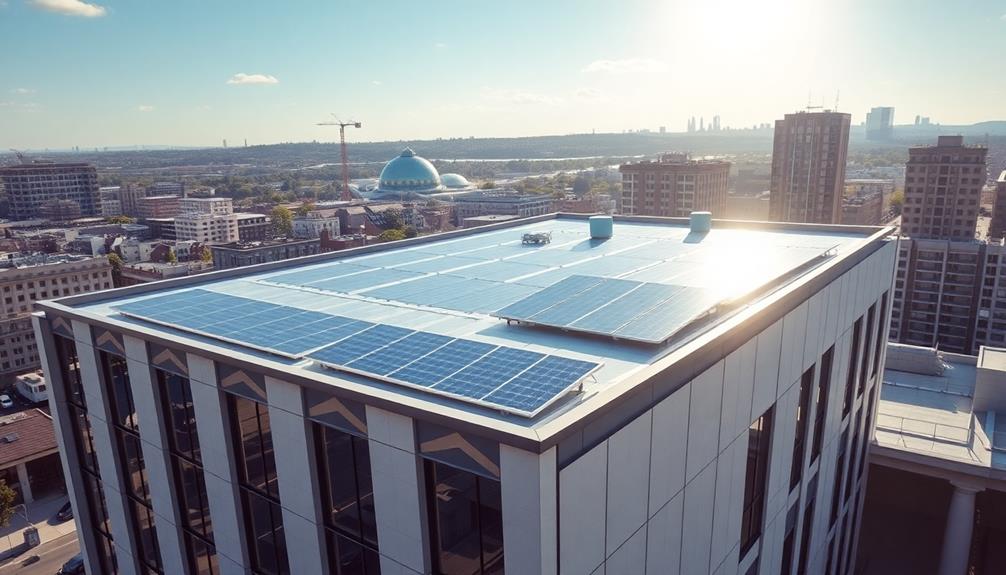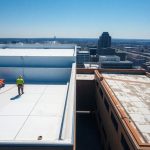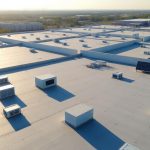Flat roofing for commercial buildings is a strategic choice, offering a myriad of advantages including energy efficiency, cost-effectiveness, and ideal space utilization. Featuring a nearly horizontal design, these structures are crafted by certified professionals employing state-of-the-art technology and high-grade materials like Thermoplastic Polyolefin (TPO) and Ethylene Propylene Diene Monomer (EPDM). Key to their longevity and performance is meticulous structural planning, ensuring effective load distribution and water drainage. Flat roofing systems not only support environmental sustainability through the use of green materials but also incorporate smart monitoring technologies to enhance efficiency and preempt potential issues. Discover additional insights into our specialized services and innovative materials.
Roofing Highlights
- Flat roofing services include expert installation with durable materials like TPO, EPDM, BUR, and Modified Bitumen.
- Flat roofs offer design benefits such as improved space utilization and energy efficiency for commercial buildings.
- Regular maintenance, including bi-annual inspections and protective coatings, extends flat roof lifespan.
- Smart roof monitoring with IoT technology enhances efficiency and reduces overall operational costs.
- Sustainable roofing practices are growing, providing eco-friendly options with green and bio-based materials.
Definition of Flat Roofing

Our business specializes in providing top-quality flat roofing services for commercial buildings, ensuring that our clients receive durable and cost-effective solutions tailored to their specific needs. We employ certified and experienced roofing professionals who utilize the latest industry techniques and high-grade materials to deliver superior results.
By conducting in-depth assessments and leveraging state-of-the-art technology, we can identify the most suitable roofing options for your property, enhancing its energy efficiency and longevity. For residential applications, our roofing solutions feature steep slope application designs that are both affordable and backed with quality guarantees.
Our commitment to Google best practices means that we provide clear communication, timely updates, and transparent pricing, ensuring a seamless and trustworthy customer experience. Whether you require installation, repair, or maintenance services, our team is dedicated to exceeding your expectations and safeguarding your commercial investment.
Structural Design Basics
Flat roofing, commonly used in commercial buildings, is defined by its nearly horizontal design, featuring a slight pitch to facilitate water drainage. These roof structures demand meticulous planning and execution, with an emphasis on load distribution, materials selection, and drainage efficiency to guarantee both functionality and longevity in various climatic conditions. The creation of a safe and effective flat roof lies in its structural design basics, where every element is thoughtfully integrated to support the overarching architectural needs of the building.
Understanding the complexities of flat roof design begins with recognizing the importance of precise load-bearing calculations, accounting for potential burden from equipment installations and environmental factors, such as snow and wind. The demand for a robust framework is imperative, often involving steel, concrete, or engineered wood to distribute weight effectively and prevent structural stress. This necessitates an expert approach in designing a support grid that adheres to building codes and safety regulations, ensuring secure occupancy.
Furthermore, the slight gradient carefully incorporated into the roof’s design is pivotal for preventing water accumulation. This subtle inclination promotes effective water runoff, safeguarding the building from potential leakage and moisture-related concerns, which can deteriorate materials and affect insulative properties.
Material Options Overview
Selecting appropriate materials is essential to the successful implementation of flat roofing systems, as the choice greatly affects durability, weather resistance, and cost-efficiency. Commercial buildings typically utilize a few key materials, each with unique properties tailored to different environmental demands and design preferences.
Thermoplastic Polyolefin (TPO) is a widely regarded option due to its energy efficiency and reflective nature, reducing cooling costs while providing strong UV and heat resistance. Alternatively, Ethylene Propylene Diene Monomer (EPDM) offers remarkable flexibility and resilience, performing admirably under various weather conditions, making it a steadfast choice in the flat roofing segment.
Built-up Roofing (BUR) systems, consisting of multiple layers of bitumen and reinforcing fabrics, deliver reliable protection and a classic appeal by providing extensive insulation. Modified Bitumen (MB) roofs, meanwhile, bring similar benefits but offer greater flexibility and ease of installation due to polymer modifications.
While selecting materials, it is vital to participate in a dialogue with professionals to tailor decisions specific to your commercial facility’s structural needs and regional climate challenges. This collaborative approach ensures alignment with industry standards and community objectives. Empowered with knowledge about these materials, stakeholders can collaboratively implement roofing systems that foster sustainable, efficient, and cohesive commercial environments.
Maintenance and Longevity
Understanding the maintenance and longevity of flat roofing systems is essential for ensuring the long-term performance and functionality of commercial buildings. Routine maintenance not only extends the lifespan of a flat roof but also fosters a sense of security and dependability amongst building owners and occupants. With these systems, early detection of potential issues, such as ponding water or membrane punctures, can prevent costly repairs or replacements, preserving both the building’s integrity and the community’s trust.
To maintain a flat roof effectively, it is critical to conduct bi-annual inspections, coinciding with seasonal shifts, to assess any damage caused by environmental factors. Regular cleaning of drains and gutters will avert water accumulation, thereby safeguarding against deterioration. Additionally, timely application of protective coatings can enhance resistance to UV radiation and extreme weather, further contributing to a roof’s durability.
Selecting professional services for maintenance ensures adherence to industry standards, thus bolstering assurance in quality and reliability. By investing in an all-encompassing maintenance strategy, building managers and property owners forge a sustainable future, one where their commercial spaces remain welcoming and secure, echoing a shared commitment to excellence.
Benefits

Flat roofing offers numerous advantages for commercial buildings, including cost efficiency, which can dramatically reduce initial investment and long-term expenditure through materials that are both affordable and energy-efficient.
Additionally, businesses in the Denver, Colorado metro area can rely on extensive and professional services for both commercial and residential needs.
Moreover, the design of flat roofs provides enhanced space utilization potential, enabling the installation of HVAC systems, solar panels, or green roofs that add value and functionality to the property.
Cost Efficiency Advantages
One of the primary cost efficiency advantages of flat roofing for commercial buildings lies in its straightforward design, which often results in reduced installation and maintenance expenses. This simplicity not only cuts down on the materials required but also shortens the installation timeline, directly benefiting the bottom line of business owners. Without the need for complex architectural elements found in pitched roofs, flat roofing systems are less labor-intensive, enabling swift project completion and minimizing disruptions to business operations.
The affordability of flat roofing extends beyond initial costs. Maintenance tasks, such as inspections and repairs, are more manageable and economical due to the accessible roof surface. Unlike more intricate roofing types, flat roofs permit easier and safer access for maintenance personnel, thereby reducing labor costs over the roof’s lifespan. Additionally, flat roofing materials, such as modified bitumen or single-ply membranes, are known for their durability and resistance to extreme weather conditions, offering long-term savings in upkeep and replacement.
Moreover, flat roofs usually require fewer layers of materials when compared to their sloped counterparts, further contributing to overall cost savings. The inherent efficiency in both material usage and energy management positions flat roofing as a judicious choice for commercial enterprises focused on fiscal responsibility.
Space Utilization Potential
A significant advantage of flat roofing for commercial buildings is the additional space it provides, which can be utilized in a variety of innovative ways. This expansive area, free from the angular constraints of pitched roofs, opens up myriad possibilities for businesses seeking to optimize their premises.
Among these, creating a green roof stands out, integrating eco-friendly initiatives while enhancing aesthetic appeal and insulating the building. Additionally, the flat surface allows businesses to install solar panels with ease, maximizing energy efficiency and contributing to sustainability goals.
Beyond the domain of environmental strategies, flat roofs offer valuable space for urban agriculture, an initiative that not only supports local food production but fosters a sense of community among employees and clients. Further, the potential for recreational areas is immense, providing terraces or break spaces for employees to recharge, thus promoting workplace wellness and satisfaction.
In high-density urban settings, coveted additional parking spots or secure storage units can be ingeniously implemented, additionally optimizing available space. Strategically leveraging the vast potential of flat roofing transforms what is often underutilized space into a vibrant component of a thriving commercial enterprise, fostering a sense of collaboration and innovation.
Maintenance and Durability
While the versatile usage of space in flat roofing for commercial buildings is impressive, equally important are the considerations of maintenance and durability that contribute substantially to its long-term benefits. Flat roofing, constructed with modern materials and advanced engineering techniques, offers notable longevity when properly cared for, making it an inherently resilient choice for commercial edifices.
Regular inspections, ideally biannual, help identify potential vulnerabilities such as membrane punctures or drainage blockages, mitigating risks of water pooling and subsequent structural damage. This proactive approach guarantees minor issues are addressed promptly, extending the roof’s lifespan substantially.
Moreover, flat roofs are often equipped with robust materials like PVC or TPO membranes, renowned for their weather-resistant properties. The integration of high-quality sealants and flashing further fortifies these structures against severe climatic challenges, ranging from torrential rains to heavy snowfall. For business owners, this translates into fewer disruptions and a reduced likelihood of costly repairs, safeguarding operational continuity and financial stability.
Ultimately, the durability and streamlined maintenance of flat roofing foster a sense of assurance within the commercial community, underscoring these roofs as a prudent investment that aligns with their aspirations for sustainable, long-term stewardship of their properties.
New Materials and Technologies

The landscape of flat roofing for commercial buildings is rapidly evolving, with new materials and technologies offering unprecedented opportunities for improvement in areas such as durability, sustainability, and intelligence. Advanced roofing membranes have been developed to provide enhanced protection and longevity, while eco-friendly roofing options now allow businesses to meet green building standards and reduce their environmental impact. Additionally, smart roof monitoring systems are transforming maintenance protocols by offering real-time data and actionable insights, thereby mitigating potential issues before they become costly problems.
| Technology | Benefit |
|---|---|
| Advanced Roofing Membranes | Enhanced protection and longevity |
| Eco-Friendly Roofing Options | Sustainability and reduced impact |
| Smart Roof Monitoring | Real-time data and issue prevention |
Advanced Roofing Membranes
With the evolution of building technology, advanced roofing membranes have emerged as a pivotal innovation for commercial flat roofing systems. These membranes, crafted from state-of-the-art materials like thermoplastic polyolefin (TPO) and ethylene propylene diene monomer (EPDM), offer unparalleled durability, flexibility, and weather resistance. Designed to meet the demanding needs of commercial structures, these membranes play an integral role in protecting buildings from the elements, maintaining a stable indoor environment, and reducing energy consumption.
Enhanced by superior manufacturing techniques, these roofing solutions are tailored to facilitate seamless installation, which minimizes leaks and extends the lifespan of the roof.
Incorporating advanced roofing membranes into commercial properties signifies a commitment to embracing cutting-edge technologies and upholding high standards within the industry. Offering a range of benefits beyond basic protection, they also contribute to improved insulation, reducing the burden on HVAC systems. This efficient energy management fosters a sense of community and shared responsibility among business owners who prioritize sustainability and cost-effectiveness.
Additionally, these membranes are designed to accommodate foot traffic, allowing for easy maintenance and enhancing their practicality. Such advancements in roofing systems underscore the collective progress toward innovative, robust solutions in commercial building design.
Eco-Friendly Roofing Options
Building upon the advancements seen in roofing membranes, eco-friendly roofing options are rapidly gaining traction in the commercial sector. As sustainability becomes increasingly paramount, businesses integrating these novel solutions not only contribute to environmental conservation but also align with a growing consumer expectation for ecological responsibility.
Materials such as thermoplastic polyolefin (TPO) and ethylene propylene diene monomer (EPDM) are renowned for their reflective properties, which diminish urban heat and reduce cooling costs, thus promoting energy efficiency.
Additionally, green roofs, which involve cultivation of vegetation atop commercial buildings, are gaining popularity due to their multifaceted benefits. These green systems offer enhanced insulation, stormwater absorption, and improved air quality while providing aesthetic appeal and a sense of community belonging.
Innovatively, bio-based materials derived from renewable resources are beginning to replace traditional components, further cementing the movement towards fully sustainable operations.
Furthermore, the integration of recycled materials in roofing contributes substantially to resource conservation and waste reduction, aligning with broader environmental goals. These advances in eco-friendly roofing not only comply with regulatory requirements but also foster a cooperative spirit among businesses aiming to support a greener future.
This emphasis on sustainable roofing helps businesses build robust identities centered on environmental stewardship.
Smart Roof Monitoring
Frequently, innovations in smart roof monitoring technologies are revolutionizing the way commercial buildings manage and maintain their roofing systems. These cutting-edge solutions integrate advanced sensors and data analytics, allowing building owners and facility managers to proactively address potential issues before they escalate into costly repairs. By harnessing real-time data insights, smart monitoring systems can detect moisture levels, temperature fluctuations, and structural movements, providing an unprecedented level of oversight and maintenance precision.
For a community that values sustainability and long-term asset protection, smart roof monitoring is an essential component in ensuring the longevity and integrity of flat roofing systems. Enhanced by the Internet of Things (IoT) technology, these systems facilitate seamless connectivity and real-time communication with building management systems, ultimately leading to improved energy efficiency and reduced operational costs. Users enjoy the knowledge that their investments are safeguarded by innovative technology that understands and anticipates their needs.
As businesses continue to embrace this paradigm shift, the inclusion of smart monitoring services in roofing strategies underscores a commitment to forward-thinking practices. This not only fosters a sense of security and belonging within the community, but also promotes a smart, connected, and resilient infrastructure for future generations.
Connect With Us
Ready to transform your commercial building with a durable and efficient flat roof? Discover ARCM Information to get in touch with experts who can provide the guidance you need.
Our expert team is here to guide you every step of the way. Don’t wait any longer to enhance your property’s value and performance. Call us today at (303) 306-8384 for a free consultation and discover how we can meet your roofing needs.
Let’s start building a stronger future together!
Roofing FAQ
What Is the Average Lifespan of a Flat Roof on Commercial Buildings?
The average lifespan of a flat roof ranges from 10 to 30 years, contingent upon factors such as material quality, maintenance practices, and climatic conditions, fostering a sense of belonging through shared industry knowledge and effective asset management.
How Often Should Flat Roofs Be Inspected and Maintained?
Flat roofs should ideally be inspected bi-annually to facilitate early detection of potential issues and maintain performance. Regular maintenance guarantees longevity and suitable functionality, fostering a sense of reliability and security within the commercial community.
Are Flat Roofs Prone to Water Pooling or Drainage Issues?
Flat roofs, due to their minimal slope, can be susceptible to water pooling and drainage issues. Proper design, regular inspections, and maintenance are essential to mitigate these risks, ensuring long-lasting function and performance, promoting inclusivity in our community.
Can Solar Panels Be Installed on Flat Roofs?
Solar panels can be effectively installed on flat roofs, offering flexibility in panel orientation and maximizing exposure to sunlight. This setup fosters a sustainable and efficient energy solution, aligning with the community’s progressive vision for renewable energy integration.
What Are the Common Causes of Damage to Flat Roofing Systems?
Common causes of flat roofing damage include ponding water, thermal stress, UV degradation, and poor installation practices. By understanding these issues, you join a community dedicated to ensuring resilient roofing solutions that protect and enhance property value.




